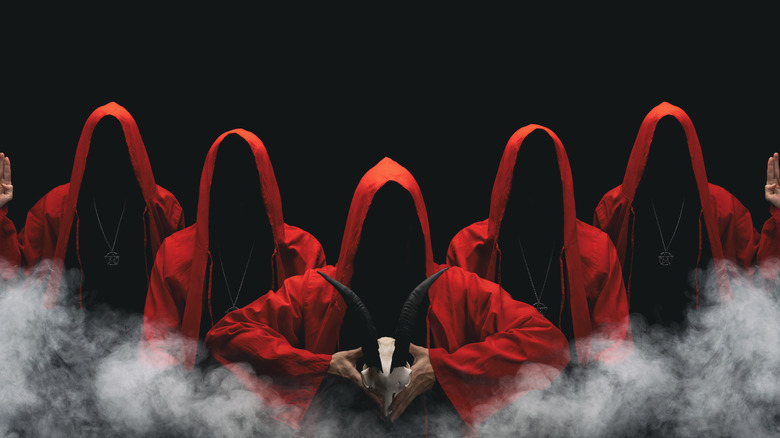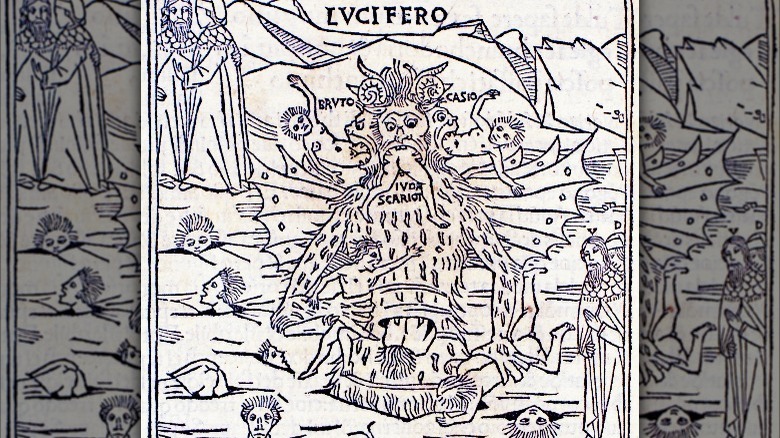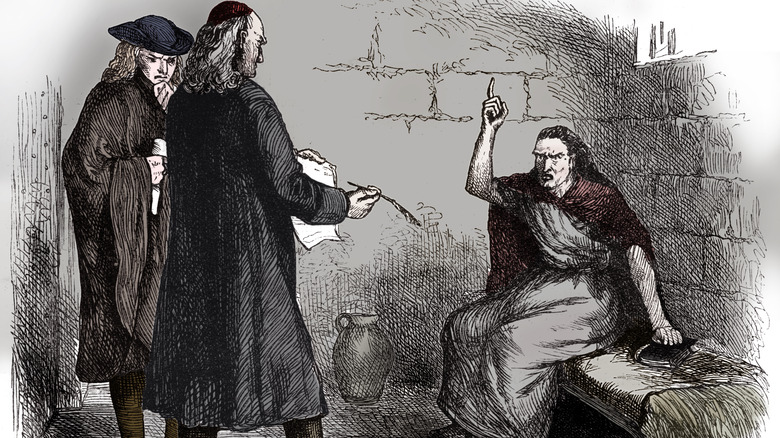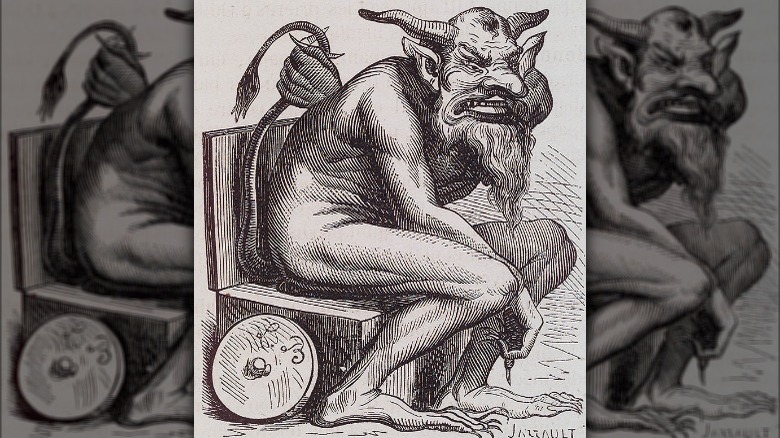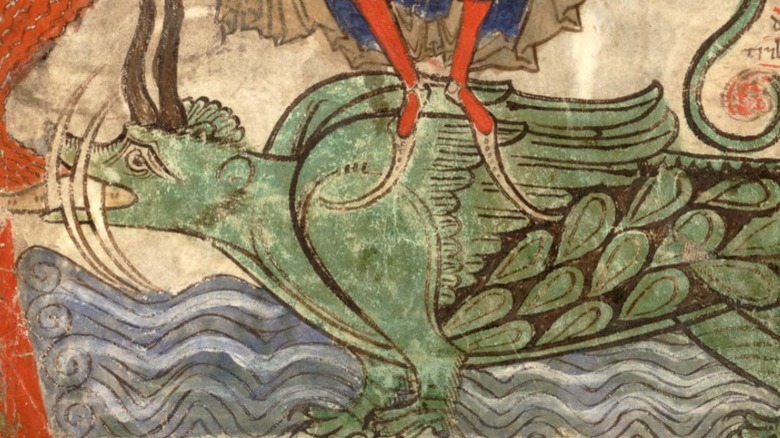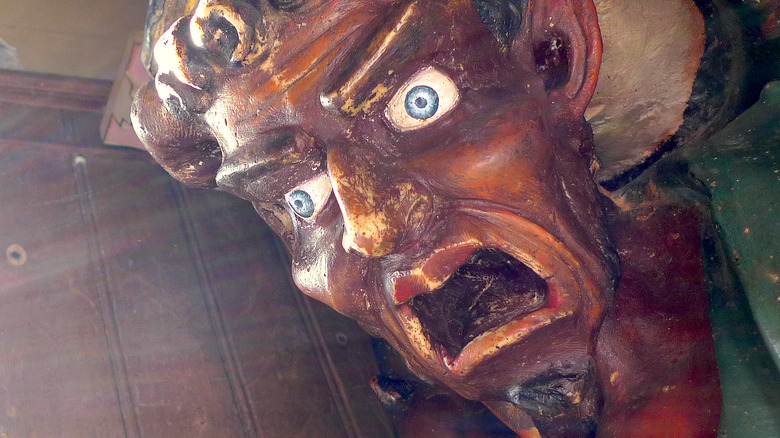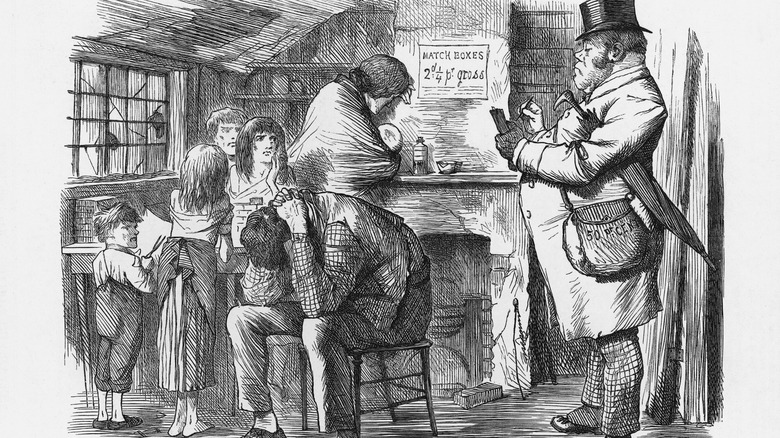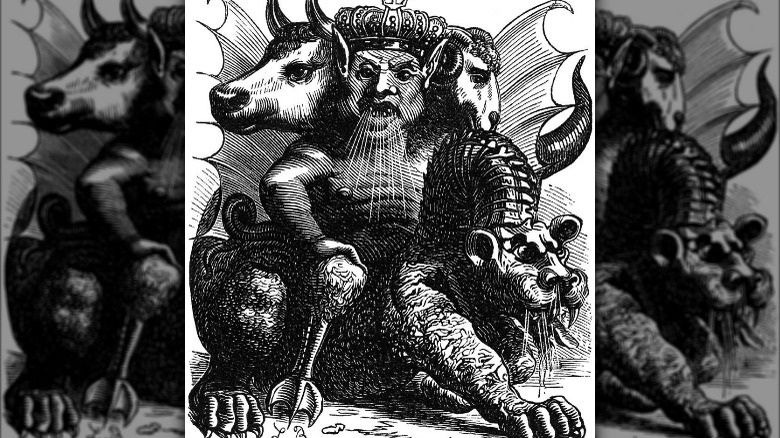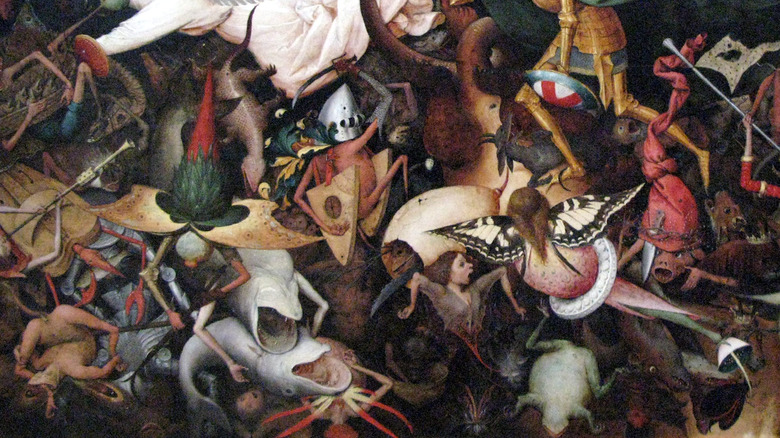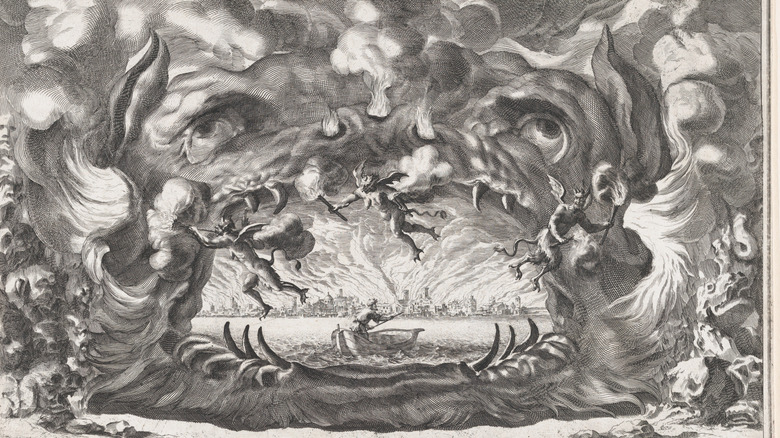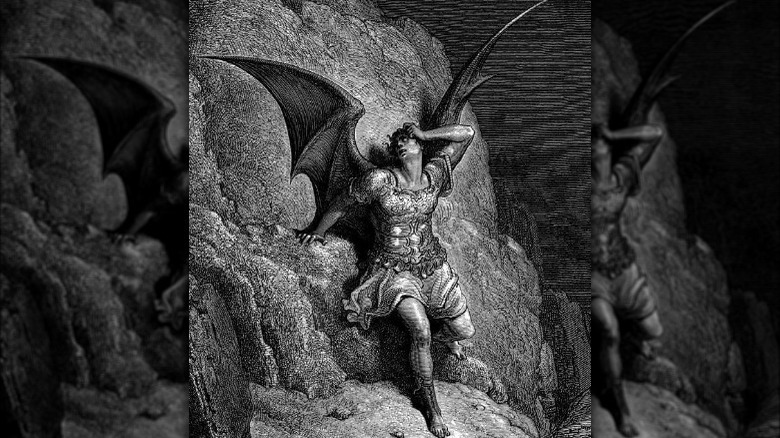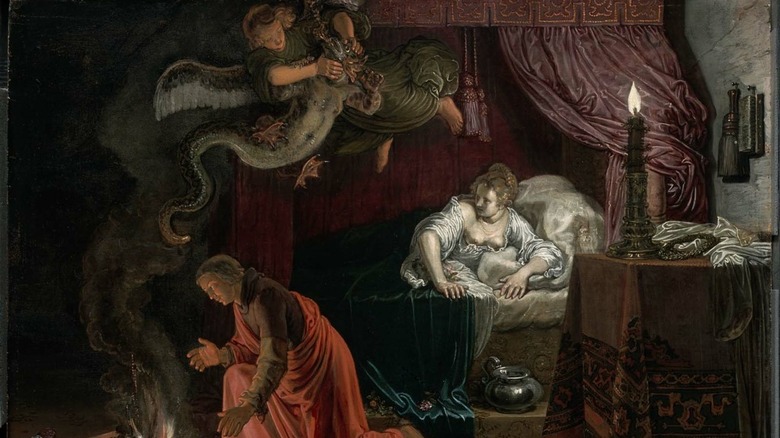The Untold Truth Of The Seven Princes Of Hell
The Seven Princes of Hell are a collection of fearsome foes spread across various religions and cultures, but they find their origins in the writings of notorious witch hunter and German bishop Peter Binsfeld, who tortured confessions out of supposed witches that turned into what he perceived as the chief villains behind witchcraft — these seven princes. Each one lorded over a specific sin, and each one has made numerous appearances across various religious texts, from the Bible itself to the book of Tobit. Some started as angels themselves, most were created by God, and the links to Christianity go deeper than that.
They've also worked their way into literature, particularly of Binsfeld's time. Works such as "Paradise Lost" and Dante's "Inferno" feature the Princes in various forms, and demonology experts across the centuries have kept them nice and organized in various encyclopedias like the "Dictionnaire Infernal." The results differ from source to source, but a few core ideas remain the same. For instance, each Prince was its own entity, even if they were often conflated with one another and each demon has significant power that has been seen throughout history.
According to Binsfeld, the Princes were divided as such, according to Mythology & Fiction Explained, Lucifer presided over pride and Satan presided over wrath. Beelzebub represented gluttony, Belphegor symbolized sloth, Leviathan was in charge of envy, Asmodeus encouraged lust, and finally, Mammon presided over greed.
None of them are friendly by any means, but here are some untold truths about them.
Lucifer's name means light-bearer
The name "Lucifer" has many meanings and interpretations, according to the "Encyclopedia of Demons in World Religions and Cultures" by Theresa Bane, but most of them refer to the angel that Lucifer was before his attempted coup of heaven. The list of meanings includes light-bearer, giver of light, morning star, and a personal favorite, lightbeard. The story of his name comes from his creation by God himself.
Throughout debates in Christianity and tying back into the Bible, Lucifer is often conflated with Satan, and also with Beelzebub, but the traits that Binsfeld attributes to the three separate them as different entities and in Lucifer's case, his name sets him up as one of the most interesting princes of hell, given the power he had before his failed rebellion in heaven. This failed rebellion gives to another interpretation of what his name means, according to Bane — "he who shuns the light."
Interestingly, Lucifer also has a place in classical mythology as the bringer of the dawn, according to Britannica, though he has no accompanying myth or legend attached to his character.
Beelzebub was behind the Salem Witch Trials
There is so much overlap between the historical accounts of witches and warlocks and the power of demons. Binsfeld himself was a notorious witch hunter who used confessions obtained through torture to build out his seven princes of hell. That being the case, it makes sense that "outbursts" of witchcraft, if you will, are often attached to the powers of a demon or evil entity.
According to Puritan Cotton Mather, in his writing "Of Beelzebub and His Plot" (via Bartleby), it was Beelzebub who was behind the sudden onset of witchcraft in his backyard. Mather was a prominent figure in the Salem trials, and it's interesting that he chose Beelzebub to discuss of all the other princes of hell. It could be seen as another conflation of the devil and his various monikers, but throughout history, specific names are chosen for specific instances that back up Binsfeld's classifications. For instance, in the "Encyclopedia of Demons in World Religions and Cultures," by Theresa Bane, there are numerous ties linking Beelzebub to divination and possession — traits that Mather and his contemporaries piled on the accused witches.
Adding to that, the Arabic meaning places him as the "patron god of witches," according to the Sunday Guardian.
Whatever you flush down the toilet goes to Belphegor
In what has to be one of the strangest tidbits surrounding a Prince of Hell, the patron prince of sloth, Belphegor, also has a very curious preference in terms of sacrifices. According to various demonic grimoires, Belphegor accepts all human excrement as an offering. For instance, according to the 1818 French "Dictionnaire Infernal" by Jacques Collin de Plancy, "one renders homage to him on a toilet," and "one offers him the ignoble residue of ones' digestion." The same notion is repeated in Theresa Bane's "Encyclopedia of Demons in World Religions and Cultures," where she writes plainly, "Belphegor accepts offerings of excrement."
What this has to do with his status as the nefarious figurehead of sloth is a bit befuddling, but it does tie in conveniently with his frequent representation on a toilet himself. One such illustration appears in the "Dictionnaire Infernal," but there are memes galore in the modern day that depict the goat-horned deity seemingly in deep contemplation on the can.
Leviathan was a literal monster
Leviathan is the figurehead of envy, though her history tracks all the way back to the Bible in making her a separate entity. While Beelzebub, Lucifer, Satan, and the like are often conflated, Leviathan has been and seemingly always was a separate creature who was, quite literally, a monster. More specifically, a monster of the sea, mentioned in the Bible as the female counterpart to Behemoth, the male beast on land. If you want to get even more specific in appearance, Theresa Bane's "Encyclopedia of Demons in World Religions and Cultures" describes Leviathan as "a monstrous female sea creature three hundred miles long with eyes glowing as brightly as twin suns."
Leviathan makes another appearance in Revelation, according to Howard Wallace's article, "Leviathan and the Beast in Revelation," though she isn't mentioned by name. In Revelations 12:3, a great red dragon with seven heads emerges from the sea and Wallace draws the connection that this is Leviathan, fighting in the war between good and evil, since Leviathan was known to have seven heads as well. Later in Revelations, a beast rises out of the Earth as well and this, according to Wallace, is Behemoth, the mate of Leviathan.
Asmodeus has three heads and some wicked powers
Asmodeus is the prince that presides over the sin of lust. He has many interpretations and variations, similar to his dark prince brethren, but most interpretations are in agreement about his relatively terrifying appearance.
You may think the prince of lust would be something more lustful and, if nothing else, human, but instead, he apparently appears as a creature with three heads. In the French "Dictionnaire Infernal," the first head is a bull, the second is a ram or sheep, and the third is a fire-breathing man. "Dictionnaire Infernal" also adds that he has the foot of a goose and, because apparently all that isn't enough already, he rides a dragon while sporting a lance with a flag.
Pick and choose which physical traits from which compendium, it still creates a monstrous visage that is understandably feared throughout his appearances in the Talmud.
Beelzebub is known as Lord of the Flies
Beelzebub is often conflated with Satan and Lucifer, along with the more standardized "devil," but Binsfeld identified plenty of unique characteristics in each to fathom them into different entities. Beelzebub especially has a very specific connection to flies that Lucifer and Satan don't. While flies can be found in various demonic connections (like the Amityville horror house), Beelzebub is the one most often hailed as the "Lord of the Flies," according to Theresa Bane's "Encyclopedia of Demons in World Religions and Cultures." Such a Lord of Flies is he, that he is often depicted as a giant fly himself, though there are variants on his appearance including horns, tails, tall as a tower, goose feet, etc.
However, it's the connection to flies that separates him from his contemporaries. According to the "Dictionnaire Infernal," he has complete power over flies on earth and uses them to ruin harvests. Taking that a step further, he is also the leader of the Order of the Flies, according to Bane's "Encyclopedia," which is a specific entourage in hell filled with all of Beelzebub's lieutenants and underlings.
There is a third reason he is known as the Lord of Flies, and it is because he, himself, was capable of flying, according to Mythology & Fiction Explained. His title also translated to "Lord of Fliers" for that same reason.
Jesus warned about Mammon
In the whole "battle of good vs evil" scenario, there are rivals and weaknesses among the host of heaven and the host of hell. For instance, Asmodeus had a personal rivalry with St. John, according to Theresa Bane's "Encyclopedia of Demons in World Religions and Cultures." While nothing explicitly says that Jesus had a specific rivalry with Mammon, it was the Christian Messiah who mentioned this particular prince by name in Matthew 6:24: "You cannot serve both God and Mammon."
The simplest interpretation is that Mammon is the figurehead of greed. As E. P. Groenewald puts it in his article "God and Mammon," this dichotomy between masters showcases just how much power Mammon had over humanity. There are countless references to Mammon in conjunction with capitalism as well, including links to the British empire, via the Economic History Review, and whether or not this was in service of Mammon. Of course, this would refer to the figurative Mammon, being the face of greed and empire, but the usage of the specific demonic entity can be seen in the "Dictionnaire Infernal," which states how Mammon taught humanity to "wrest away" the treasures of the earth.
There is also the simple matter of the capitalization of Mammon in the Bible too. Though in the modern vernacular, it's simply a term used to describe material wealth, via Britannica.
Asmodeus deposed King Solomon
The Talmud brings one of the best stories relating to one of the seven princes of hell, and it occurs in the book of Tobit. It discusses the famous King Solomon, who above all things, asked God for wisdom. Wisdom or not, Solomon made a bit of an unwise decision with Asmodeus, known in the text by his Hebrew name Ashmedai. According to the story, Solomon needed some guidance in building the temple, so he took a rabbi's advice and bound some demons to find the instructions given by God.
While there are multiple versions of this story, according to the Katz Center — one in which the demon is helpful and friendly, one in which he is used to build the temple, and one where he deposes Solomon and takes his place on the throne — every one of them brings Asmodeus into the close proximity and perhaps servitude of King Solomon. In the version where Solomon is deposed, he so unwisely unbound the demon as a sort of challenge, at which point Asmodeus literally punted Solomon across the world, leaving Solomon with the unenviable task of returning to the throne and taking it, which he does in the end. Still though, for a while there the temple was ruled by a prince of hell.
Lucifer was the instigator of the war in heaven
The book of Revelations tells the story of the battle fought in heaven between Michael and his angels against the rebelling future-demons and their angels. The leader of the rebels was Lucifer himself. According to Mythology and Fiction Explained, Lucifer had grown fed up with the state of the universe, believed himself the only perfect being, saw himself as superior to humankind, and could not understand God's love of them. In order to instigate change, he convinced one-third of the angels to side with him and rise up against the rule of God.
Despite how quick it may have seemed in the Bible, the war lasted for years. Lucifer turned himself into a dragon, Leviathan and Behemoth showed up, but in the end, Lucifer lost the fight and was cast from heaven. That, however, is also where one version of the story deviates — Lucifer's rebellion may well have continued when he was cast out of heaven. Knowing how much God loved his humans, he corrupted Adam and Eve to stick it to God out of pride (his deadly sin) and envy.
Belphegor is a shapeshifter
While Belphegor was assigned to the crime of sloth, his actual abilities go much deeper than being depicted seated on a toilet. The whole notion of him being slothful comes from his being inventive enough to create devices to do the work for him, and by extension, by tricking humans into doing the work and then claiming credit for himself, according to Mythology & Fiction Explained. So in a sense, his sloth gave way to ingenuity, and one of his tricks as a deceitful being is his ability to take whatever form is most beneficial for him in the moment.
According to Theresa Bane's "Encyclopedia of Demons in World Religions and Cultures," that meant that Belphegor could appear as anything from a young girl to a giant phallus — whatever was more likely to get the job done. Tracing him back to his origins as Baal-Peor, he was both a sun god and a moon goddess to the Moabites who worshipped him. Again, whatever was most likely to get people to do what he wanted. Call him a crowd pleaser.
Leviathan guards the gates of hell
Given the sheer size of Leviathan and her standing as a massive creature so big (300 miles long, even) she has been classified as a sea monster, it makes sense that the rulers of hell found another use for her monstrous size — as the gates of hell itself. In that sense, along with swallowing all those guilty of envy, Leviathan's gullet also served as the general entry point into eternal damnation.
This concept arises through Anglo-Saxon art depicting the fires of hell spewing forth from a massive mouth that has been equated with Leviathan. In the artistic renditions, and as a concept dating back to the middle ages, this mouth is known as "hellmouth," according to Mythology & Fiction Explained.
This hellmouth motif can be seen in various works of Renaissance art, for instance "The Last Judgement" by Giacomo Rossignolo, as well as a slew of other examples discussed in "Welcome To Medieval Hellmouth Illuminations and their Correlation to Fantasy and Pop Culture," by Kristina Rust.
Satan's name is also a common noun
Satan is by far the most common of the seven princes of Hell to be associated with the devil in general, but Binsfeld sorted him as the patron prince of the deadly sin of wrath. He was supposedly the primary opponent of Jesus in the battle for humanity, but Satan was so prevalent in the realm of man that his name became a common noun as well. In the Hebrew scripture, there was a difference between the Satan and a satan. The latter referred to a human adversary or obstacle, while the former was the actual prince of hell himself.
According to "The Devil Made David Do It... or 'Did' He?" by Ryan E. Stokes, early Hebrew writings didn't necessarily subscribe to a belief in malevolent beings such as demons, let alone the seven princes of hell. So when it came time to reprint the Bible, they used satan as a general term, which often took on supernatural connotations, but without committing to it being a specific entity.
Elaine Pagels digs even deeper in "The Social History of Satan, the "Intimate Enemy": A Preliminary Sketch," highlighting how, at the time, Jews didn't believe that a satan operated on his own volition, and that all of these supernatural beings were of Godly nature and therefore working according to his will.
Asmodeus fell in love once
It may not seem like a prince of hell thing to fall in love, but if ever one was going to, surely it would be the prince of lust himself, the three-headed Asmodeus. The story goes, according to the book of Tobit, that Asmodeus fell in love with a woman named Sarah, but given that he was a horrid three-headed demon with no hope of true love, he watched from afar, only coming close enough to kill her would-be husband every time she attempted to marry an actual human man.
This happened seven times. Each time Sarah would try to marry, Asmodeus would sneak up the night of the wedding and kill the husband to-be. Unfortunately for Sarah, she planned to marry again, this time to a man named Tobias. This time, however, Asmodeus's schemes were at an end. With the help of the Archangel Raphael, Tobias defeated Asmodeus with a fish heart and a liver placed over burning coals. Apparently, Asmodeus couldn't stand the smell and fled the scene as soon as he arrived.
